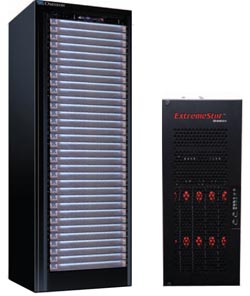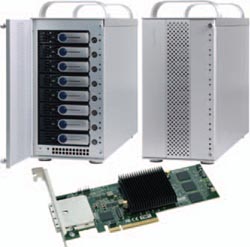Content Storage Systems

Large-volume storage systems are the "gray matter" of any enterprise, office complex, university, or government facility. When we think of storage systems, we tend to think of massive racks in data centers, which provide access to the volumes of financial, R&D, and sales/marketing data that is the lifeblood of any organization. With the digitization of audio and video content, these massive storage devices with terabyte (and higher)
capacity are also now commonplace in the broadcast, media, and entertainment industries.
With the rapid adoption of AV technologies like high-definition videoconferencing, rich media streaming, and webcasting, organizations of all types are realizing the need for storage systems for content that goes far beyond numbers and documentation. The Enterprise Strategy Group, an industry analyst firm, predicts that worldwide demand for storage capacity will approach 90,000 petabytes (that's 90 million terabytes) by the year 2012. Much of that increase is likely to be driven by high-definition video content. Market research firm IDC has also predicted that the total capacity of storage systems will increase more than 50 percent per year.
SELECTING MEDIA STORAGE
With so many choices of storage platforms and architectures, the selection of a system to support an enterprise-class media production and distribution department can be daunting. So make sure you start with a long-term view of the challenge. First, when presented with the opportunity to reduce the number of disparate storage devices with a resilient central repository, take it. Eliminating "puddles of storage" reduces administration and that nagging where-did-I-leave-that-clip feeling. That leads to the second point....
Your central repository

will be of little use if your talented content producers can't get to what they need when they need it. Make sure that the consolidated storage has the flexibility and performance necessary to support the facility's workflow. This workflow includes the applications you use every day, so make sure they are supported and are tightly integrated.
A daily selection of features, industry news, and analysis for tech managers. Sign up below.
Non-linear editing is probably the most demanding application for central storage. A system that only supports one brand of edit platform is not well suited to today's evolving operations, so look for agnostic storage solutions that are open to all edit workflows. Finally, look for a system that leverages your investment in hardware. Disk drive technology will progress much faster than the surrounding controlling systems. The optimum solution will accept and utilize higher-capacity replacement drives as they become available without a complete overhaul.
The AVNetwork staff are storytellers focused on the professional audiovisual and technology industry. Their mission is to keep readers up-to-date on the latest AV/IT industry and product news, emerging trends, and inspiring installations.
